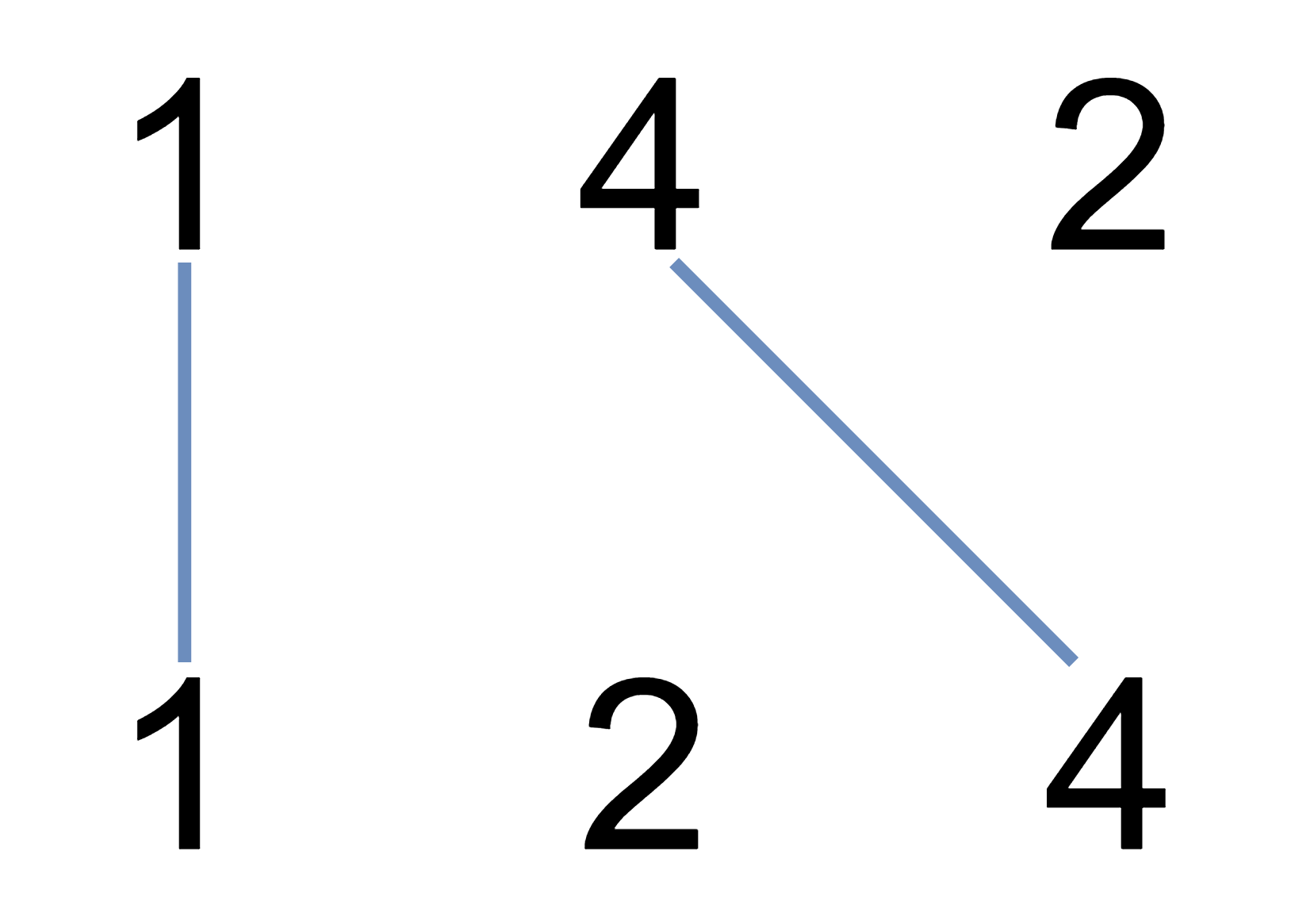不相交的线
约 858 字大约 3 分钟
2025-02-27
1035. 不相交的线
在两条独立的水平线上按给定的顺序写下 nums1 和 nums2 中的整数。
现在,可以绘制一些连接两个数字 nums1[i] 和 nums2[j] 的直线,这些直线需要同时满足:
nums1[i] == nums2[j]- 且绘制的直线不与任何其他连线(非水平线)相交。
请注意,连线即使在端点也不能相交:每个数字只能属于一条连线。
以这种方法绘制线条,并返回可以绘制的最大连线数。
示例 1:

输入:nums1 = [1,4,2], nums2 = [1,2,4]
输出:2
解释:可以画出两条不交叉的线,如上图所示。
但无法画出第三条不相交的直线,因为从 nums1[1]=4 到 nums2[2]=4 的直线将与从 nums1[2]=2 到 nums2[1]=2 的直线相交。示例 2:
输入:nums1 = [2,5,1,2,5], nums2 = [10,5,2,1,5,2]
输出:3示例 3:
输入:nums1 = [1,3,7,1,7,5], nums2 = [1,9,2,5,1]
输出:2提示:
1 <= nums1.length, nums2.length <= 5001 <= nums1[i], nums2[j] <= 2000
动态规划-数组递推
本质是最长公共子序列问题。
class Solution {
public int maxUncrossedLines(int[] nums1, int[] nums2) {
int m = nums1.length, n = nums2.length; // 获取 nums1 和 nums2 的长度
// 定义 dp 数组,dp[i][j] 表示 nums1[0..i-1] 和 nums2[0..j-1] 的最长不相交子序列的长度,i和j指的是前i个和前j个元素。
int[][] dp = new int[m + 1][n + 1];
// 遍历 nums1 的每个元素
for (int i = 1; i <= m; i++) {
int num1 = nums1[i - 1]; // 获取 nums1 中的第 i 个元素
// 遍历 nums2 的每个元素
for (int j = 1; j <= n; j++) {
int num2 = nums2[j - 1]; // 获取 nums2 中的第 j 个元素
if (num1 == num2) {
// 如果 nums1[i-1] 和 nums2[j-1] 相同,则它们可以构成一条不相交的线
dp[i][j] = dp[i - 1][j - 1] + 1;
} else {
// 否则,取 dp[i-1][j] 和 dp[i][j-1] 的较大值。重点。
dp[i][j] = Math.max(dp[i - 1][j], dp[i][j - 1]);
}
}
}
// 返回 nums1 和 nums2 的最长不相交子序列的长度
return dp[m][n];
}
}时间复杂度O(mn),空间复杂度O(mn)
滚动更新
用两个数组而不是一个变量+一个数组来进行滚动更新。
class Solution {
public int maxUncrossedLines(int[] nums1, int[] nums2) {
int m = nums1.length, n = nums2.length;
// 定义两个一维数组,prevRow 表示上一行,currentRow 表示当前行
int[] prevRow = new int[n + 1];
int[] currentRow = new int[n + 1];
// 遍历 nums1 的每个元素
for (int i = 1; i <= m; i++) {
int num1 = nums1[i - 1]; // 获取 nums1 中的第 i 个元素
// 遍历 nums2 的每个元素
for (int j = 1; j <= n; j++) {
int num2 = nums2[j - 1]; // 获取 nums2 中的第 j 个元素
if (num1 == num2) {
// 如果 nums1[i-1] 和 nums2[j-1] 相同,则可以构成一条不相交的线
currentRow[j] = prevRow[j - 1] + 1;
} else {
// 否则,取 prevRow[j] 和 currentRow[j-1] 的较大值
currentRow[j] = Math.max(prevRow[j], currentRow[j - 1]);
}
}
// 将当前行变为上一行,准备进入下一次循环。重点。
// Arrays.copyOfRange 是替代 System.arraycopy 的一个方法,但它会返回一个新的数组。
// System.arraycopy 直接在现有数组中进行复制,适用于复制到已分配的数组中。System.arraycopy 十分高效。
// prevRow = Arrays.copyOfRange(currentRow, 0, n + 1);
System.arraycopy(currentRow, 0, prevRow, 0, n + 1);
}
// 返回 nums1 和 nums2 的最长不相交子序列的长度
return currentRow[n];
}
}